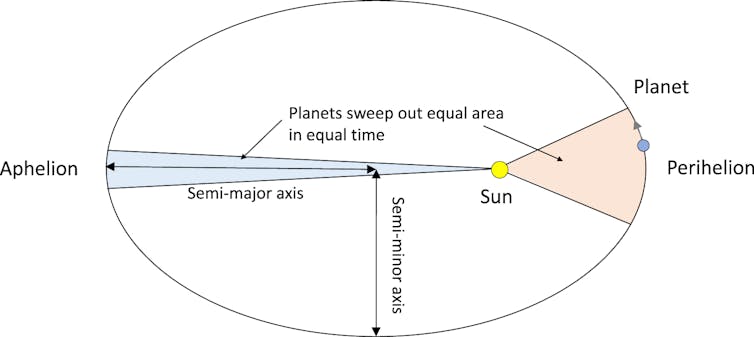
The average distance between the Earth and the Sun as the Earth orbits the Sun is 150 million kilometers.
If you’ve ever learned about how the Earth orbits the Sun, you’ve likely thought that our planet follows an elliptical path, which brings it closer to the Sun at certain times of the year than at other times. You have good reason to think so too: most textbooks show things this way.
In fact, many people believe that the Earth is closer to the sun in the summer than in the winter. As it happens, this is true during the Southern Hemisphere summer, but not during the Northern Hemisphere summer.
In the Southern Hemisphere, the Earth is 5 million kilometers closer to the Sun in summer than in winter, but the opposite is true in the Northern Hemisphere. The average distance between the Earth and the Sun is 150 million kilometers, and the main cause of seasonal changes is the tilt of the Earth, so that each pole is sometimes closer to the Sun and sometimes further away.
Therefore, the deviation of Earth’s orbit from perfect circularity is relatively small. But why does it so often appear to be in the shape of an egg? How can we see what’s really going on?
Consider bicycle wheels
To try and understand how round the orbits of the Earth and other planets are, I decided to compare the shape of the Earth’s orbit to a regular 26-inch bicycle wheel by shrinking the actual size to fit – and consulted my local bike shop to find out what these deviations would be for a real What does the wheel mean? I was very surprised by the results.
The orbit is much closer to a perfect circle than I previously thought. If the track were a 26-inch (660.4 mm) bicycle wheel, the deviation from a perfect circle would be less than 0.1 mm. This is equivalent to a thin layer of paint – a perfect circle is essentially indistinguishable to the naked eye.

I’ve looked at other planets too. The orbits of Venus and Neptune are closer to perfect circles, with Venus’ orbit deviating by only 14 μm (a μm, or micron, is one millionth of a meter) and Neptune’s orbit deviating by 31 μm.
The planets with the smallest circular orbits are Mars and Mercury. If the Mars orbit were a 26-inch bicycle wheel, it would be less than 3 millimeters off—if you were riding a bike with a wheel that was that far off, it would be barely noticeable.
Mercury’s orbit is the least circular, with a deviation of 14 mm, although this is still only 2%.
If you have a bicycle, chances are its wheels aren’t even as round as Mars’ orbit. If you’ve had a serious collision with a curb or rock, your front wheels may even be rounder than the orbit of Mercury.
tiny deviation
Mathematically minded readers may have a question after reading the above: If the earth is 150 million kilometers away from the sun on average, and this distance changes by 5 million kilometers in a year, shouldn’t there be a little deviation in its orbit? More than 3%?

The answer to this question is that the sun is not at the center of the ellipse, but is offset to one side as a point called the focus. If, during its formation, a planet moves at just the right speed to counteract gravity, it will orbit around it.
However, in the real universe, planets rarely orbit at the correct speed. Sometimes they travel faster, sometimes slower, which is only possible with elliptical orbits.
Coming to a successful conclusion
Thousands of years ago, the ancient Greeks believed that all celestial bodies orbited the Earth in perfect circles.
This idea persisted for about 1,500 years, until Polish astronomer Nicolaus Copernicus (1473-1543) realized that planets (including Earth) actually orbit the sun.
Copernicus believed that orbits were circular. Later, the German astronomer and mathematician Johannes Kepler (1571-1630) realized he was wrong and proposed three laws of planetary motion.
The first law is that the orbits of planets are elliptical, not circular. The third law relates the size of a planet’s orbit to the time it takes in a way that’s a little too complicated for us to discuss in depth.
The second law is that if you draw a line from the sun to any given planet, the line will sweep the same area in the same amount of time as the planet moves. Think of pizza – a narrow wedge of a large pizza can have the same area as a wide wedge of a small pizza. This happens because the planets move faster the closer they are to the sun.
The main reason why orbits are drawn as ellipses in textbooks is to prove Kepler’s second law. If the Earth’s orbit were plotted as shown on a correctly scaled diagram, it would be impossible to see any difference in the wedge.

However, this may give the impression that the Earth’s orbit is more elliptical than it actually is. There’s nothing actually wrong with such diagrams—they’re just an exaggeration, a mathematical caricature that emphasizes important features.
Although the ancient Greeks were wrong about the Earth being at the center of the solar system, they weren’t too far wrong about the orbits of the planets. So, pardon the pun, we’re back to square one.
(author:Stephen Hughes, Honorary Senior Lecturer, School of Mathematics and Physics, University of Queensland and University of Queensland College)
(Disclosure Statement: Stephen Hughes does not work for, consult, own shares in, or receive funding from any company or organization that would benefit from this article, and has disclosed no relevant relationships beyond his academic appointment)
This article is republished from The Conversation under a Creative Commons license. Read the original article.
(Except for the headline, this story has not been edited by NDTV staff and is published from a syndicated feed.)






